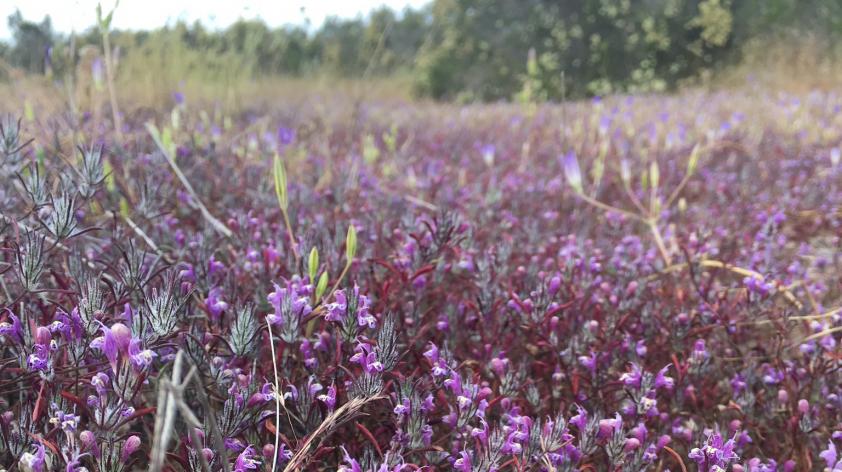
Conserving San Diego’s Vernal Pools
Vernal pools are temporary wetlands that fill with water during winter rains and are very slow to dry out, not becoming completely dry until summer. This pattern of winter rain and dry summers and fall is typical of Mediterranean climates and will be familiar to anyone living in Southern California. While vernal pools once covered roughly 200 square miles in San Diego County, it’s estimated that 97% have been destroyed due to land development for housing, agriculture, and grazing. The vernal pools that still remain are threatened by the spread of invasive grasses, off-road vehicles, and urbanization.
In an effort to conserve and restore these endangered habitats, the Plant Conservation team has made seed collections from many endemic vernal pool species this year. In the coming months I’ll discuss some of the vernal pool specialist plants that are our focus, and some of the characteristics of vernal pools that make the habitat so unique.
Pogogyne is a very small genus of plants in the mint family (Lamiaceae) with 7 distinct species. They are known as mesa mints, and in San Diego County there are 2 species and they exist only in vernal pool habitat.
Pogogyne abramsii is known as the San Diego mesa mint and is a State and Federally listed endangered species. It is only found in vernal pools in San Diego County and nowhere else on Earth. It is an annual herb that is dependent upon the inundation of vernal pools with rainwater and temperature cues in order to germinate. It usually flowers in May and June when the water has dried from the pools. The seeds of this species float, providing a mechanism for dispersal in years with lots of rain, when pools can interconnect. San Diego mesa mint seeds have also been observed germinating from the pellets of rabbits, showing the species can spread with the help of cottontails!
Pogogyne nudiuscula is known as Otay mesa mint, referencing the very small area in which it occurs. Also a State and Federally listed endangered species, it is believed that the species once occurred in 10 or more locations in southern San Diego County and in vernal pools just south of the border in Mexico as well. Otay mesa mint is now found in only 3 locations, all south of the Otay River in San Diego County, and hasn’t been seen in Mexico for over 25 years. Genetic work has shown that San Diego mesa mint and Otay mesa mint are in fact separate species, though they are closely related. San Diego mesa mint has a gray hairy calyx, reddish foliage and stems, and only 2 flowers per node, while the Otay mesa mint is much greener throughout its growth cycle, has a smooth calyx, and 6 or more flowers per node.
We are very excited to be contributing to the conservation of these mesa mints. They are completely unique to San Diego County, existing nowhere else, and are integral to the vernal pool ecosystem, considered one of the most endangered habitats on Earth.
If you’re interested in learning about other rare plant species we’ve been conserving and the science behind our seed banking efforts. Click the links below:
http://institute.sandiegozoo.org/science-blog/conserving-san-diego%E2%80%99s-geophytes
http://institute.sandiegozoo.org/science-blog/california-plant-rescue-2016-review
http://institute.sandiegozoo.org/science-blog/freezing-san-diego%E2%80%99s-rarest-seeds
http://institute.sandiegozoo.org/science-blog/saving-san-diego%E2%80%99s-rare-mints
http://institute.sandiegozoo.org/science-blog/rare-plant-seed-collections-san-diego-county
http://institute.sandiegozoo.org/science-blog/conserving-rare-plants-otay-mountain
http://institute.sandiegozoo.org/science-blog/california-plant-rescue













